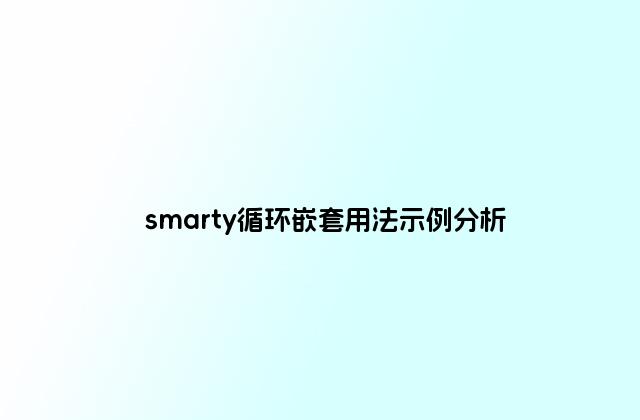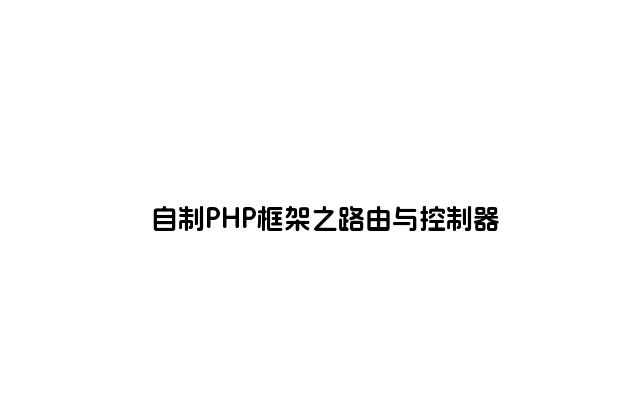
本文实例讲述了smarty循环嵌套用法。分享给大家供大家参考,具体如下:
test3.php:
<?php
require "main.php";
$forum = array(
array("category_id" => 1, "category_name" => "公告区",
"topic" => array(
array("topic_id" => 1, "topic_name" => "站务公告")
)
),
array("category_id" => 2, "category_name" => "文学专区",
"topic" => array(
array("topic_id" => 2, "topic_name" => "好书介绍"),
array("topic_id" => 3, "topic_name" => "奇文共赏")
)
),
array("category_id" => 3, "category_name" => "电脑专区",
"topic" => array(
array("topic_id" => 4, "topic_name" => "硬件周边"),
array("topic_id" => 5, "topic_name" => "软件讨论")
)
)
);
$tpl->assign("forum", $forum);
$tpl->display("test3.htm");
?>
样版的写法如下:
templates/test3.htm:
<html>
<head>
<title>循环嵌套测试</title>
</head>
<body>
<table width="200" border="0" align="center" cellpadding="3" cellspacing="0">
<{section name=sec1 loop=$forum}>
<tr>
<td colspan="2"><{$forum[sec1].category_name}></td>
</tr>
<{section name=sec2 loop=$forum[sec1].topic}>
<tr>
<td width="25"> </td>
<td width="164"><{$forum[sec1].topic[sec2].topic_name}></td>
</tr>
<{/section}>
<{/section}>
</table>
</body>
</html>
test2.php:
<?php
require_once('./include/db_fns.php');
include_once("./Smarty/libs/Smarty.class.php"); //包含Smarty类文件
$smarty = new Smarty(); //建立Smarty实例对象$Smarty
$smarty->template_dir = "./templates/dedecms";//设置模板目录
$smarty->compile_dir = "templates/templates_c"; //设置编译目录
$smarty->assign("template_url", "./");
$smarty->assign("$site_url", "http://www.gimoo.net/");
$smarty->assign("$site_name", "文章管理系统");
$smarty->left_delimiter = "<{"; //设置左边界符
$smarty->right_delimiter = "}>"; //设置右边界符
$db_conn = db_connect();
$query = "SELECT cat_ID,cat_name FROM categories ORDER BY cat_ID DESC";
$result = mysql_query($query);
$i = 5;
while(($row = mysql_fetch_array($result)) && $i > 0)
{
$query2="SELECT ID, post_title, post_date
FROM post
WHERE post.post_category =$row[cat_ID]
AND post_status <> 'unpbulish'
ORDER BY post_date DESC";
$result2=mysql_query($query2);
$i = 5;
while(($row2 = mysql_fetch_array($result2)) && $i > 0)
{
$row2[post_date]=date('m-d',strtotime($row2[post_date]));
$category = array("cat_ID"=>"$row[cat_ID]","cat_name"=>"$row[cat_name]",
"post"=>array("ID"=>"$row2[ID]",
"post_title"=>"$row2[post_title]" ,
"post_category"=>"$row2[post_category]" ,
"post_date"=>"$row2[post_date]"));
$i--;
}
}
$smarty->assign("forum", $category);
$smarty->display("test2.htm");
?>
test2.htm:
<html>
<head>
<title>嵌套循环测试</title>
</head>
<body>
<table width="200" border="0" align="center" cellpadding="3" cellspacing="0">
<{section name=sec1 loop=$forum}>
<tr>
<td colspan="2"><{$forum[sec1].cat_id}></td>
</tr>
<{section name=sec2 loop=$forum[sec1].post}>
<tr>
<td width="25"> </td>
<td width="164"><{$forum[sec1].post[sec2].post_title}></td>
</tr>
<{/section}>
<{/section}>
</table>
</body>
</html>
test4.php:
<?php
require "main.php";
$my_array = array(
array("value" => "0"),
array("value" => "1"),
array("value" => "2"),
array("value" => "3"),
array("value" => "4"),
array("value" => "5"),
array("value" => "6"),
array("value" => "7"),
array("value" => "8"),
array("value" => "9"));
$tpl->assign("my_array", $my_array);
$tpl->display('test4.htm');
?>
模版的写法如下:
templates/test4.htm:
<html>
<head>
<title>横向重复表格测试</title>
</head>
<body>
<table width="500" border="1" cellspacing="0" cellpadding="3">
<tr>
<{section name=sec1 loop=$my_array}>
<td><{$my_array[sec1].value}></td>
<{if $smarty.section.sec1.rownum is div by 2}>
</tr>
<tr>
<{/if}>
<{/section}>
</tr>
</table>
</body>
</html>
重点在于 $smarty.section.sec1.rownum 这个 Smarty 变量,在 section 循环中这个变量会取得从 1 开始的索引值,所以当 rownum 能被 2 除尽时,就输出 </tr><tr> 使表格换列 (注意!是 </tr> 在前面<tr> 在后面) 。因此数字 2 就是我们在一列中想要呈现的资料笔数。各位可以由此去变化其它不同的呈现方式。
运算符有以下这些:
eq、ne、neq、gt、lt、lte、le、gte、ge、is even、is odd、is not even、is not odd、not、mod、div by、even by、odd by
示例:
<{if $bigsize ge '650'}-->
<img src="http://www.gimoo.net/t/1811/photo/<{$photo}-->" border="0" width="650" class="product_photo" />
<{else}-->
<img src="http://www.gimoo.net/t/1811/photo/<{$photo}-->" border="0" class="product_photo" />
<{/if}-->
以前不常用smarty,这两天有个朋友的网站要改;顺手用了一下,还是挺有意思的。
关于capture 的说明:
capture函数的作用是收集模板输出的数据到一个变量里,而不是把它们输出到页面.
任何在 {capture name="foo"}和{/capture}之间的数据都被收到了由函数的名称属性指定的变量里($foo).
收集的信息可以用在特殊变量$smarty里.
例如capture.foo就收集了以上数据.如果函数没有名字属性,将使用"default".
每个{capture}都必须对应{/capture},也不能嵌套使用capture函数.
更多关于Smarty相关内容感兴趣的读者可查看本站专题:《smarty模板入门基础教程》、《PHP模板技术总结》、《PHP基于pdo操作数据库技巧总结》、《PHP运算与运算符用法总结》、《PHP网络编程技巧总结》、《PHP基本语法入门教程》、《php面向对象程序设计入门教程》、《php字符串(string)用法总结》、《php+mysql数据库操作入门教程》及《php常见数据库操作技巧汇总》
希望本文所述对大家基于smarty模板的PHP程序设计有所帮助。






